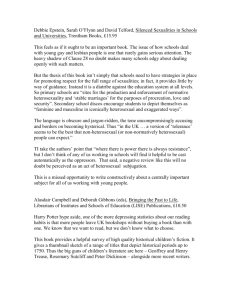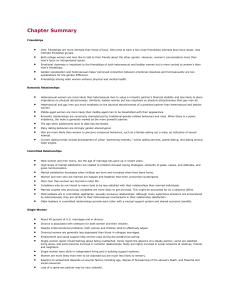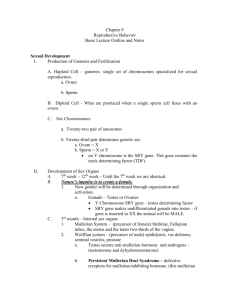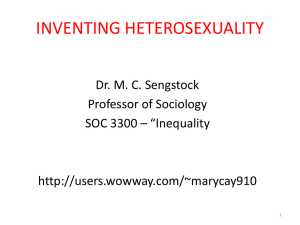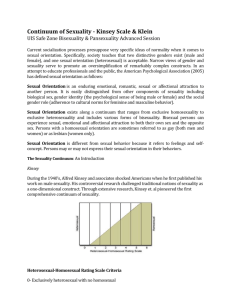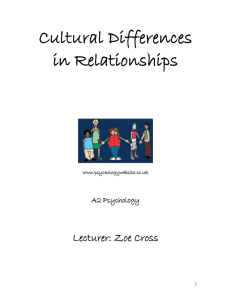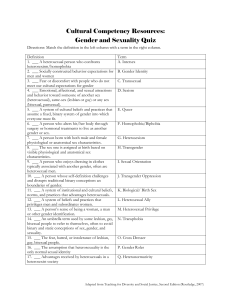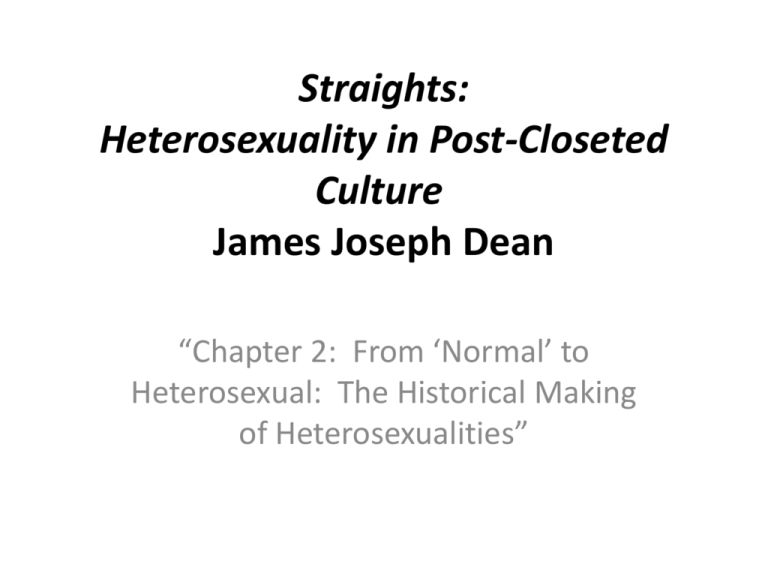
Straights:
Heterosexuality in Post-Closeted
Culture
James Joseph Dean
“Chapter 2: From ‘Normal’ to
Heterosexual: The Historical Making
of Heterosexualities”
Concepts
• The closet refers to a specific social-historical
condition in which a regime of compulsory
heterosexuality imposed patterns of passing and a
double life upon the majority of individuals for
whom same-sex desire was salient
• This included prohibiting homosexuals to be served
in bars and restaurants, firing them from federal
government jobs to censoring their depictions or
even mentioning them in Hollywood films
• A post-closeted dynamic is marked by the pervasive
presence of openly gay and lesbian individuals and
a pattern of cultural normalization
Thesis and Analytical Focus
• This chapter uses the historical scholarship on the rise of
heterosexual masculinities and heterosexual femininities in
the US from the 1890s to the 1990s to map the rise and fall
of the closet
• It provides a historical argument for Dean’s sociological
study of the importance of understanding a post-closeted
cultural dynamic in contemporary society
• It provides a historical overview of the historiographical
scholarship which documents the relation between
heterosexual/homosexual desires (feelings of sexual
excitement), behaviors (sexual acts such as oral, vaginal
and anal sex) and identities (how one self-defines oneself in
relation to categories and groups of sexualities)
Queer Theory’s Analytical
Reorientation of Sexualities Studies
• In The Epistemology of the Closet, Eve Sedgwick argues
“that many nodes of the thought and knowledge in
twentieth-century Western culture as a whole are
structured—indeed, fractured—by a chronic, now
endemic crisis of homo/heterosexual definition”
(1990:1).
• This analytical move by Sedgwick and queer theorists
moved scholars away from lesbian/gay studies and to
analyzing the power relations of the
homo/heterosexual definition, from focusing exclusively
on homosexualities to sexualities more broadly, thus
including heterosexualities
• This move is central to this book’s project of turning the
lens back on heterosexuals and making their identities
and its privileges subject to social and historical
analysis.
The Historical Construction of
Heterosexualities and the Roles of
Gender and Race
• The development of heterosexual identities consolidated a
sexual hierarchy that constructed heterosexualities as natural,
the internalization of psychological health, and the normative
ideal of one’s personal and public self
• On gender differences, the historical development of
heterosexual men’s identities must be understood in relation to
homosexual men’s and, likewise, for women’s heterosexual and
homosexual identity developments, as gender played a central
role in the differential formation of male homosexualities and
heterosexualities earlier than female homosexualities and
heterosexualities
• The hierarchical boundaries between heterosexualities and
homosexualities reinforced a racial hierarchy that marked black
sexualities as pathological and abnormal in comparison to white
sexualities, which served as the embodiment of health,
normality, and beauty (D’Emilio and Freedman 2012).
Before Heterosexuality
• In his book The Invention of Heterosexuality,
historian Jonathan Ned Katz (1996) states
that the terms “homosexual” and
“heterosexual” were invented in 1868
• Maria Kertbeny, a German law reformer,
coined the term “homosexual” in his effort
to amend sodomy laws in Germany and used
the word “heterosexual” in 1880 in his
public defense of homosexuality
• Heterosexual identity is neither reducible to
the reproduction of the human species nor
is it a simple extension of one’s sex
Before Heterosexuality
• From the colonial era to the late 19th century in
America, homosexuality was prohibited through
sodomy laws, which were aimed not at homosexual
individuals but nonprocreative, nonmarital sexual
acts
• From 1820 to 1860, heterosexuality did not exist;
rather, sex was based on notions of a true manhood,
a true womanhood, and a spiritual love
• The major division was whether sex took place within
or outside of marriage. Sex was only permissible as
an act of procreation in marriage.
• Marriage was the cornerstone of Victorian life, and a
proper womanhood, manhood and progeny
Before Heterosexuality
• However, a shift occurred between 1860 to 1890.
Heterosexuality and homosexuality emerged as
discursive discourses in medical-scientific,
particularly sexology, legal, literary, and other
knowledge domains, adjoining at times or
replacing religious views that defined sexual
behaviors as sinful or not.
• Sigmund Freud is a key figure in establishing
sexual object-choice as an integral development
of the human self and that procreation is a
secondary development while pleasure is the
main purpose. He makes the heterosexual sexual
instinct into a feeling and central part of one’s
self-understanding, not an act of reproduction.
The Birth of Heterosexuality and the PreCloset Period, 1890-1930s
• A major misconception of the history of sexuality in America
is that heterosexual domination is assumed to have created a
closeted existed for homosexuals since the colonial era or
before. This was not the case.
• Before the development of the heterosexual/homosexual
system of sexual identity that we know, a gender system of
social organization overlaid same-sex and other-sex
behaviors.
• From roughly 1890 to 1930, “normal” men and fairies, who
were womanlike men who had sex with men, were defined
by a gendered sense of self. That is, “normal” men were
allowed to have sex with other men, as long as they
maintained both a traditional masculine display and the
dominant penetrator role in anal sex. Likewise, men who
made same-sex sexualities central to their lives were
expected to display feminine manners and assumed to take
on the role of the penetrated.
The Birth of Heterosexuality and the
Pre-Closet Period, 1890-1930s
• For women, same-sex intimacies were permitted under the
respected institution of women’s “romantic friendships” with one
another.
• Whether genital sexual relations took place between “romantic
friends” remains a matter of historical dispute, yet these female
same-sex love relationships were fundamental to the proto-lesbian
identities and subcultures that would emerge in the twentieth
century.
• The sexualization of women as lesbian or heterosexual in the 1920s
and 1930s set the frame for the homo/heterosexual definition
among women later in the century. In sum, at this historical
juncture, sexuality—heterosexuality and homosexuality—as a
distinct axis of identity was still submerged within the gender roles,
arrangements, and institutions of the period.
“Normal” Men, Fairy Culture, and Male
Homosexuality as Gender Inversion
• From the 1890s to the 1930s, working class cultures of New
York and other cities socially permitted “normal” men to
publicly socialize and have sex with other men who were
categorized as “fairies” without this stigmatizing these
“normal” men as homosexual or morally deviant.
• Chauncey explains: “So long as they [normal men]
maintained a masculine demeanor and played (or claimed
to play) only the “masculine,” or insertive, role in the
sexual encounter—so long, that is, as they eschewed the
style of the fairy and did not allow their bodies to be
sexually penetrated—neither they, the fairies, nor the
working-class public considered them to be queer” (1994,
66, italics in original).
“Normal” Men, Fairy Culture, and Male
Homosexuality as Gender Inversion
• “Normal” men included sailors, common
laborers, hoboes, and transient workers
• At this time, gender and sexuality are collapsed
together. Fairies are viewed as womanlike men
due to colored hair, powdered faces, and
comportment
• However, among the middle-class culture there
was already the development of a homosexual or
queer identity, which lead to the establishment of
heterosexuality.
• Heterosexual men reacted against both queer
men and fairies, claiming that their masculinity
was indicated by their heterosexuality
• However, queer men are invisible to the straight
world.
“Normal” Men, Fairy Culture, and Male
Homosexuality as Gender Inversion
• “As a result of the straight world’s ignorance of
the existence of a hidden middle-class gay
world—a world that did not fit the fairy
stereotype—police harassment posed
considerably less threat to that world than it did
to the fairy resorts” (103).
• The policing and arresting of homosexual resorts
and solicitations increased dramatically after
Prohibition, as it is from the 1930s to 1950s that
historians date the rise of the closet
• Further, as the Christian Gentleman declined, the
male flapper and tramp Bohemian appeared on
the American culture scene
“Normal” Men, Black Masculinity,
Sexualities, and Social Class
• Similarly, lack middle-class men of the period navigated the shift
from a Victorian industrial entrepreneur notion of masculinity to
one based in the rising consumer capitalist economy. The historian
Martin Summers (2004), in Manliness and Its Discontents: The Black
Middle Class and the Transformation of Masculinity, 1900–1930,
discusses the heterosexual/homosexual divisions and their effects
on the masculinities of aspiring middle-class black men.
• Summers compares the “normal” black male members of the
Prince Hall Freemasonry, a black fraternal order that created a
social network among black men based on their shared sense of
class standing and masculinity, to the middle-class black
homosexual male artists of the Harlem Renaissance. Both the
Prince Hall Freemasons and Harlem Renaissance artists were
experiencing a changing definition of masculinity
“Normal” Men, Black Masculinity,
Sexualities, and Social Class
• Summers views the African American and AfroCaribbean men of the Harlem Renaissance as
contesting the black middle-class “normal” masculinity
of groups of black men in New York at the time.
• For example, while this visible black gay subcultural
presence contested black middle-class norms of
respectability and heterosexual conformity, they also
provoked outbursts from Harlem pastors like Adam
Clayton who sought to enforce a respectable black
masculinity as strictly heterosexual.
The Sexual Revolution among Women
• In the 19th century, sexologists claimed that only men were
able to be actively sexual and women’s sexualities were a
response to and dependent on men’s initiation. In a
parallel, homosexual women were “female inverts,” as
“inversion” of the female character into that of a male is
what it took in this discourse for a woman to pursue another
woman, as only a man would (Chauncey 1982; SmithRosenberg 1989).
• The shift in the 20th century discourses of sexology,
psychoanalysis, and medical science to conceptualizing
women’s sexualities, heterosexual and homosexual, as
active, self-initiating, and agentic, is central to the
development of both heterosexual femininities and
homosexual ones.
The Sexual Revolution among Women
• Three groups of heterosexual women emerge between
1890 to 1930: (1) working-class wage earners, (2)
young middle-class “flappers,” and (3) the second
generation of independent feminist “new women”
(Allen 1931; Meyerowitz 1988, 1990; Ryan 1983, 2006;
Peiss 1983, 1986).
• As a result of the influences of the first sexual
revolution on American women, according to the
historian Joanne Meyerowitz (1990, 274),
– women began to adopt more sexual, or at least less modest,
styles; shorter skirts, cosmetics, bobbed hair, and cigarettes,
once the styles of prostitutes, all seemed evidence of a
larger change in mores when adopted by “respectable”
working- and middle-class women. Men and women
mingled freely in new commercialized recreation industries
and in workplaces. And surveys of the middle class revealed
increases in premarital intercourse.
The Sexual Revolution among Women
• From middle-class flappers who went slumming in working-class districts
to middle- and upper-class “new women” who lived in these
neighborhoods and observed their working-class counterparts’ behaviors,
these more affluent women’s heterosexual practices and subculture—
flappers and “new women” —were influenced by the working-class wageearning women of the time.
• This group of working-class women wage earners included black and white
women lodgers who lived in the furnished room districts of urban centers
apart from their families (Meyerowitz 1988, 1990), native white and
immigrant wage earners who lived at home (Peiss 1986), and their more
sexually permissive “charity girl” peers (Peiss 1983, 1986) who used pick
ups, and occasional prostitution to supplement their wages with meals,
gifts, and money from men (Meyerowitz 1990).
• The term “charity girl” highlights the shifting sexualities among workingclass women who negotiated a continuum between becoming “fallen
women” to remaining the utmost sexually chaste ladies.
The Sexual Revolution among Women
•
•
•
•
A classic description of the flapper is: “She smoked, drank, worked, and
played side by side with men. She became preoccupied with sex—
shocking and simultaneously unshockable. She danced close, became
freer with her favors, kept her own latchkey, wore scantier attire which
emphasized her boyish, athletic form, just as she used makeup and
bobbed and dyed her hair” (McGovern 1968, 317).
However, this shift in women’s sexual agency such as the flapper as the
antithesis of her Victorian mother ties them to men in new and
consciously heterosexual ways.
Whereas flappers like to have enjoy the leisurely activities of the city, the
second generation of new feminist women were often labeled as
“lesbians” by male professional who sought to discredit them and any
woman professional, reformer, educator, or feminist spokesperson.
Among some of the most famous second generation of new women are
both heterosexual ones such as Margaret Sanger and Isadora Duncan and
lesbian ones such as Gertrude Stein and Radclyffe Hall.
Women now claimed heterosexual statuses to avoid being discredited as
respectable. The development of the mannish lesbian is disseminated
into popular culture as an image of non-femininity, one heterosexual
women aimed to avoid in maintaining heterosexual privilege and female
respectability.
Heterosexual Hegemony and the Rise
of the Closet, 1930s to 1960s
• The rise of the closet as a state formation across the
country occurred through a variety of laws and policies that
were put in place from the late 1920s through the 1950s.
• After the end of Prohibition in 1932, many states made it
illegal for bars and restaurants to serve lesbians and gay
men.
• In 1934, the Production Code of the Hollywood film
industry banned depictions of homosexuality; the ban
remained in place until 1966.
• Similarly, in 1927, New York State passed a “padlock” law
that prohibited gay male and lesbian characters from being
portrayed in Broadway plays.
Heterosexual Hegemony and the Rise
of the Closet, 1930s to 1960s
•
•
•
•
What the closet’s laws and policies meant for everyday Americans is that a system
of sexual identities—homosexual and heterosexual—was being constructed in
place of and in relation to the previous era’s gender system of organization.
With the rise of heterosexuality as a new discourse of men’s and women’s selfidentities, the exclusion of all same-sex contact became the key element of the
definition of heterosexual identities.
However, the gender system did not disappear but continued to serve as an
informal set of classification codes in popular culture and common stereotypes of
heterosexual and homosexual identity practices.
For men, over the course of the 1940s, 1950s, and 1960s, the terms “fairy,”
“queer,” and “trade” started to be replaced by the predominance of “gay,” which,
like “queer” before it, emphasized a masculine gender self-presentational style
among homosexual men. The disappearance of “trade” or working-class “normal”
men—that is, men who were not homosexually identified but who would accept
homosexual men’s sexual advances—along with the new establishment of gay as
the preferred homosexual identity category over fairy and queer, represented the
development of sexual object choice and its accompanying hetero/homo binary as
distinct from the previous gender system, where homosexuality was
conceptualized as gender inversion and emblematized by the figure of the fairy.
Heterosexual Hegemony and the Rise
of the Closet, 1930s to 1960s
• As a heterosexual social order developed, a procreative
heterosexuality continued to tie men and women together
in marriages and families.
• Heterosexual men, however, started to contest the
expectations of being a breadwinner for a wife and family.
The new discourses of bachelorhood and sexual
promiscuity legitimated a nonprocreative model of
heterosexual masculinity for men.
• Heterosexual women also grew increasingly dissatisfied
with being confined to the roles of wife and mother.
Women became more sexualized, started to be increasingly
capable of economic independence, and aimed to become
active partners in “companionate marriages.”
Heterosexual Hegemony and the Rise
of the Closet, 1930s to 1960s
• Black women’s sexualities were part of debates over “cheesecake”
images, images viewed as acceptable mass-produced
representations of variably naked women.
• In this debate the issue of the racial stereotyping of black sexuality
as animalistic and concerns over black female respectability were
raised. Some viewed it as progress to have black women admired
in “cheesecake” images (Meyerowitz 1996).
• Black men’s migration to northern cities did nothing to mitigate the
pernicious stereotypes of their heterosexual masculinities as
dangerous, violent, and hypersexual (McGruder 2010). Escaping the
Jim Crow segregation and threat of lynching in the South, black men
wound up facing disproportionate arrests and harsher punishments
for rape in the criminal justice system of northern states. “Between
1930 and 1964, ninety percent of the men executed in the United
States for rape were black,” observe D’Emilio and Freedman (2012,
297).
Heterosexual Hegemony and the Rise
of the Closet, 1930s to 1960s
• By the 1940s, a general cultural consciousness
around women who desire women is widely known
as indicating a lesbian identity, and World War II
plays a prominent role in the rise of lesbian
subcultures in ways that the World War I did not
• With Alfred Kinsey’s report on American women’s
surprising practices of masturbation and rates of
premarital and extramarital sex in the ’50s, the
1960s mainstreamed casual non-marital sex among
heterosexual women as a trend
• Helen Gurley Brown and her book Sex and the
Single Girl, published in 1962, exemplify this
Heterosexual Hegemony and the
Rise of the Closet, 1930s to 1960s
• Before Brown’s book, Hugh Hefner provided a new
model of heterosexual masculinity for men with
Playboy magazine.
• If men before were confined by the need to be
married and a “breadwinner,” Hefner introduces
the idea of the lascivious heterosexual bachelor;
men should date and have sex with women but
marriage is not the goal of this new cultural model.
• For women, gender-traditional presentations of self
were a way for women to pass as heterosexual if
lesbian, and they remained a central force in
maintaining compulsory heterosexuality among
women.
Heterosexual Hegemony and the Rise
of the Closet, 1930s to 1960s
• The 1950s were the end of an era of conformity
in American history. Over the next three
decades, heterosexual and homosexual
boundaries would be contested, and the cultures
of straights and gays would no longer remain so
separate, distinct, and unknown to each other.
• The grievances of sexual, gender, and racial
minorities that had been ignored and overlooked
would be heard and publicly aired in boycotts,
marches, and riots, as well as in courtrooms,
workplaces, and governmental bodies.
Challenges to Heterosexual Hegemony and
the Decline of the Closet, 1960s to 1990s
• From 1920 to 1960, a culture of sexual liberalism dominated the
erotic lives of heterosexual Americans. It promoted limited sexual
experimentation on a pathway to a lifetime marriage.
• With the decline of a culture of sexual liberalism, the 1960s
witnessed the rise of a culture of sexual pluralism, where practices
of premarital sex, cohabitation, divorce, and nonprocreative casual
sex, especially with the availability of the birth control pill, made
heterosexual and homosexual intimate practices start to look more
and more alike (D’Emilio and Freedman 2012; Faderman 1991).
• With the growing strength of a national LGBT movement during this
period, heterosexual hegemony faced a set of wide-ranging
struggles in expressions of sexual and gender identities, relations,
and, more crucially, political movements against homophobia and
normative heterosexuality.
Challenges to Heterosexual Hegemony and
the Decline of the Closet, 1960s to 1990s
• By the 1960s and 1970s, and with the ethic of sexual pluralism
in full swing, heterosexual and homosexual intimacy practices
start to look more and more alike
• With the Stonewall Riots of 1969 and their politics of coming
out to straight friends, family members, and coworkers, there is
national shift in the enforcement of the closet and the
beginning of its decline.
• From the emergence of political and legal organizations (such as
the National Gay and Lesbian Task Force, the Human Rights
Campaign, and Lambda Legal Defense) to the development of
domestic partner benefits to gay adoption laws and the spread
of antidiscrimination ordinances across the country, the decline
of the closet as a form of state repression is seen in the rights,
changes in state policy, and recognition garnered by lesbians
and gay men throughout the 1970s and 1980s.
Challenges to Heterosexual Hegemony and
the Decline of the Closet, 1960s to 1990s
• It is in the context of the decline of the closet and the rise
of a post-closeted culture that Dean explores shifts and
changes in the social construction of heterosexual identity
performances.
• Heterosexual men and women negotiate the establishment
of their identity statuses in an era of lesbian and gay
tolerance, visibility, and rights, and their performances of
heterosexual masculinity and femininity are increasingly
varied as a result.
• From their relations with lesbian and gay coworkers and
acquaintances to friends and family members,
heterosexuals face a set of choices in deciding what kinds
of boundaries to employ in their interactions with LGBT
individuals.
Discussion Questions
1.
2.
3.
4.
5.
6.
7.
Explain the difference between heterosexual behavior and identity. When did heterosexual
identity emerge in US history?
What is the relationship between gender and “normal” men and women versus gender and fairy
and queer men and romantic female friends during the pre-closet period from 1890s to 1930s?
Explain how the closet of homophobic state formation prohibited homosexuality and promoted
heterosexuality, starting in the 1930s to the 1960s.
Three groups of women represent the development of a more conscious heterosexual identity
among Americans during the turn of the twentieth century. These women included: (1) black
and white working-class wage earners; (2) female flappers; and (3) the second generation of
feminist “new women.” Define each group and their relation to the gender and sexual norms of
their time period.
Sexual liberalism is said to have defined American culture from the 1920s to the 1960s. Define
sexual liberalism and what it meant for Americans during this historical period.
The 1950s witnessed the development of Playboy Magazine, the 1970s sparked the hippie
movement, and the 1990s marked the rise of metrosexuality (see Ch. 5, pp. 185-187 on
metrosexuality). Discuss how each of those sociohistorical trends influenced straight men’s
sexual-gender identities and whether you view playboys, hippies, and metrosexuals as elements
of culture that straight men appropriate. What other cultural trends influence straight
masculinities today?
The Stonewall riots and sexual pluralism changed social life for straights and LGBT people in the
1960s. How so? List two social changes that occurred after Stonewall and two social changes
encompassed by sexual pluralism.


